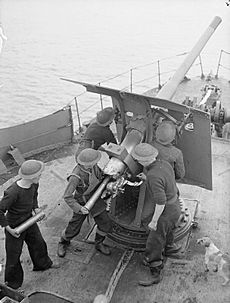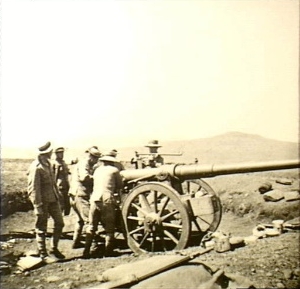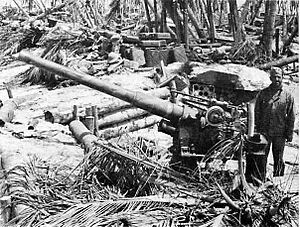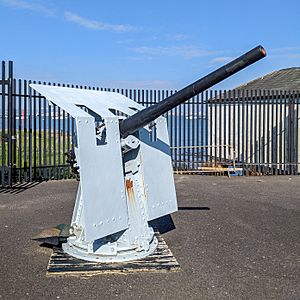QF 12-pounder 12 cwt naval gun facts for kids
Quick facts for kids QF 12-pounder 12 cwt naval gunType 41 3-inch (7.62 cm) 40 calibre gun |
|
|---|---|
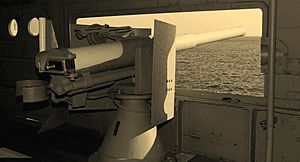
Type 41 3-inch (7.62 cm) 40 calibre gun on the Japanese battleship Mikasa
|
|
| Type | Naval gun Coastal artillery |
| Place of origin | United Kingdom |
| Service history | |
| In service | 1894–1945 |
| Used by | United Kingdom Kingdom of Italy Empire of Japan |
| Wars | Second Boer War British colonial conflicts Irish 1916 Easter Rising Boxer Rebellion Russo-Japanese War World War I World War II |
| Production history | |
| Designed | 1893 |
| Manufacturer | Elswick Ordnance Company, Vickers, Japan Steel Works Canadian Pacific Railway< Gio. Ansaldo & C. |
| No. built | Mk I, Mk II 4,737 Mk V 3,494 |
| Variants | Mk I, Mk II, Mk V |
| Specifications | |
| Mass | 12 cwt (0.6 tons, 510 kg) |
| Length | 10 ft 3 in (3.12 m) |
| Barrel length | 10 ft (3 m) |
|
|
|
| Shell | UK & Japan : Separate-loading QF Italy : Fixed QF |
| Calibre | 3-inch (7.62 cm) |
| Breech | single-motion screw |
| Elevation | mounting dependent |
| Traverse | mounting dependent |
| Rate of fire | 15 rounds per minute |
| Muzzle velocity | 2,210 ft/s (670 m/s) |
| Effective firing range | 11,750 yd (10,740 m) at 40° elevation |
| Feed system | Breech-loaded |
The QF 12-pounder 12-cwt gun was a powerful and useful naval gun. It was called "Quick-Firing" (QF) because it could shoot very fast. This gun was first used in 1894 and stayed in service until the mid-1900s.
It was a 3-inch (76.2 mm) calibre gun. This means the inside of the barrel was about 3 inches wide. The gun was built by companies like Armstrong Whitworth and Elswick in the United Kingdom. The British Royal Navy used it on their warships. They also sold it to other countries that were their allies. Sometimes, it was even used on land.
In Britain, "12-pounder" meant the weight of the bullet it fired. "12 cwt" (which means 12 hundredweight) was the weight of the gun's barrel and breech (the back part where the bullet goes in). This helped people tell it apart from other "12-pounder" guns.
Japan also used a version of this gun called the Type 41 3-inch (7.62 cm)/40. It was on many early Japanese battleships and cruisers. Italy also made these guns under a special agreement, calling them the 76.2 mm/40 (3").
Contents
The QF 12-pounder in the United Kingdom
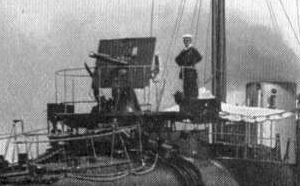
The first versions of the gun, called Mk I and Mk II, were made from layers of steel. They were used on many Royal Navy destroyers. At first, they were the main guns. Later, they became secondary armament (backup guns) to fight against submarines and torpedo boats. These guns were also put on the decks of D-class and E-class submarines.
By 1939, out of 4,737 Mk I and Mk II guns made, about 3,494 were still ready for the Royal Navy. A newer version, the Mk V, had a barrel made from a single piece of steel. These Mk V guns were used on smaller escort ships, like destroyers, and on armed merchant ships. They could be aimed at both high and low angles, so they could also shoot down airplanes as anti-aircraft guns.
Used in the South African War (1899–1902)
This gun was mainly for ships, and its strong kickback (recoil) meant it worked best when it was fixed in one place. It wasn't really made to be a mobile gun for land battles. However, during the South African War, the British army needed help. The Boer army had stronger artillery (big guns). So, the Royal Navy brought 16 QF 12-pounder guns from their warships onto land.
They put these guns on special, makeshift carriages. These carriages had solid wooden parts and small wheels from local wagons. The guns could shoot up to 10,000-yard (9,100 m) (about 9 kilometers). This long range was very helpful for the army during the war. These guns were called "long twelves" to tell them apart from other 12-pounder guns that had shorter barrels and couldn't shoot as far.
Normally, these guns were fired using an electric system. But in the field, it was hard to keep batteries charged. So, soldiers often switched to using percussion tubes, which were simpler to use.
Six more of these guns were meant for a Japanese battleship being built in England. But a wealthy woman named Lady Meux bought them in 1900. She had them fitted with proper field carriages and sent them to South Africa. These guns were special because they were given directly to the British commander, Lord Roberts, and became his personal property. They were known as the "Elswick Battery" and were operated by volunteers from Elswick. These guns helped throughout the war.
Used for Coast Defense
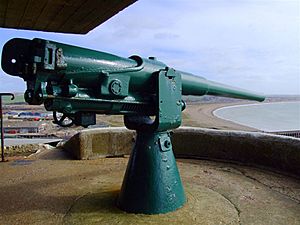
Many QF 12-pounder guns were set up on "pedestals" (strong bases) on the ground. They were used to protect harbors in the UK and other parts of the British Empire. Their job was to stop small, fast enemy ships, like torpedo boats. These guns were used for this purpose until the 1950s.
In April 1918, there were 103 of these guns used for coast defense in the UK. Many were still in use during World War II. However, by then, newer and more modern guns were also available.
To aim the gun, a gunlayer would stand on the left side. He would hook his arm over a shoulder piece to help him aim. He used his left hand to turn a wheel to raise or lower the gun. With his right hand, he held a pistol grip with the trigger to fire.
Used as Anti-Aircraft Guns
In World War I, some of the coast defense guns were changed. They were put on special wheeled carriages to make them mobile. This allowed them to be used as anti-aircraft guns, though they were not very effective against fast-moving planes.
Ammunition for the QF 12-pounder
The shells (bullets) used by the UK guns weighed about 12.5 lb (5.67 kg) when filled and ready to fire. The propellant (the explosive that pushes the shell out) was called cordite. It was usually set off by an electric primer at the bottom of the cartridge case. This primer got its power from a battery. Sometimes, if the electric system wasn't working, a different kind of primer could be used that worked by percussion (a small hammer striking it).
The QF 12-pounder in Italy
Italy made its own version of the QF 12-pounder gun. It was called the Cannon 76/40 Model 1916. Italy used these guns in many different ways during both World War I and World War II.
The QF 12-pounder in Japan
The Japanese Type 41 3-inch (76 mm) naval gun was a direct copy of the British QF 12-pounder. Japan first bought some of these guns from British companies. Later, they started making them themselves under a special agreement.
The gun was officially named the Type 41 3-inch naval gun in 1908. Later, in 1917, the Japanese Navy changed its measuring system to the metric system. So, the gun was renamed the 8 cm/40 3rd Year Type naval gun. Even though it was called an 8 cm gun, the size of the barrel didn't actually change.
This gun fired a 12.5-pound (5.7 kg) high-explosive shell. It was a very common gun on most Japanese warships built between 1890 and 1920. It was even still used during the Pacific War in World War II.
The 8 cm/40 3rd Year Type gun was also used a lot to defend Japanese islands. It served as a coastal defense gun and an anti-aircraft gun. Guns with both English and Japanese markings were found on islands like Kiska, Saipan, and Tinian after battles.
Surviving Guns
You can still see some of these historic guns today:
- One gun from the "Elswick Battery" that fought in the Second Boer War is now in the Royal Artillery Museum in Larkhill, UK.
- Another Elswick gun is with a military unit called 203 (Elswick) Battery RA (V).
- A Mk V naval gun is also at the Royal Artillery Museum in Larkhill.
- An early coast defense gun is on display at Newhaven Fort in the UK.
- Another coast defense gun can be seen at the Army Memorial Museum in Waiouru, New Zealand.
- You can find one on the battleship Mikasa in Yokosuka, Japan.
- The gun from HMS Campbeltown, which was found around 1972, is on display in Saint-Nazaire, France.
- A 12-pounder gun on a coastal defense stand is at Pendennis Castle in Falmouth, Cornwall, UK.
- The gun from HMS Overdale Wyke, a ship of the Ceylon Naval Volunteer Force, is now kept in SLNS Ranagalle.
- A good example of a World War II naval type gun can be seen at Tilbury Fort in Essex, UK.
- A World War I era 12-pounder gun is mounted on a special high-angle stand at the Predannack Anti-Aircraft battery and museum in Cornwall.
- There is also a gun at the Explosion Museum of Naval Firepower in Gosport, UK.
Images for kids
See also
- List of naval guns


